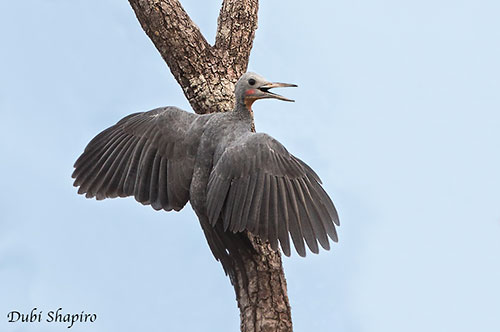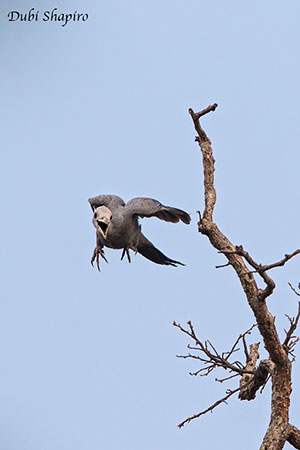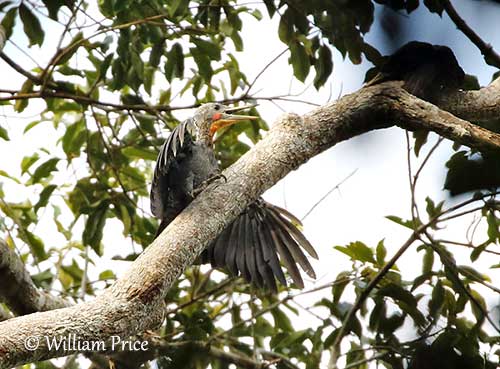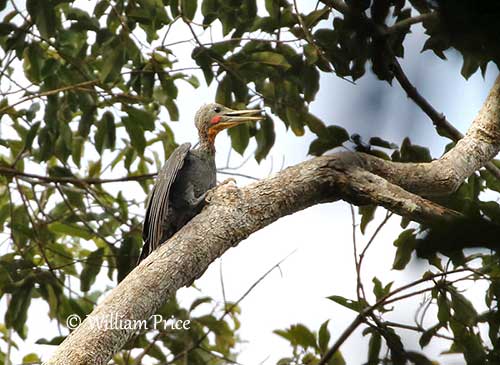
REPRODUCTION OF THIS SPECIES:
The breeding season varies according to the range. Both mates excavate the nesting hole, but usually, the male does most of this work. The hole is often very high in tree, between 9 and 45 metres above the ground. The entrance is about 10 centimetres across.
The pair may reuse an old nest or adapt a cavity abandoned by other species. Single helpers can be occasionally seen at nest.
The female lays 2-4 white eggs and both adults share the incubation, but the duration is currently unknown. The chicks are fed by both parents, and by helper when present. The fledging period is unknown, but the young remain in family group after fledging, probably until the next breeding cycle.
PROTECTION / THREATS / STATUS:
The population of the Great Slaty Woodpecker is declining due to habitat destruction through logging of old-growth forest.
The population is roughly estimated to number 260,000/550,000 individuals. The species occurs in many protected areas.
But following a rapid population decline over the past 20 years (three generations), the Great Slaty Woodpecker is currently listed as Vulnerable.
Fr: Pic meunier
Ang: Great Slaty Woodpecker
All: Puderspecht
Esp: Picatroncos Pizarroso
Ita: Picchio ardesia
Nd: Poederspecht
Sd: skifferspett
Photographers:
William Price
PBase-tereksandpiper & Flickr William Price
Dubi Shapiro
Dubi Shapiro Photo Galleries & Dubi Shapiro's Pictures on IBC
Text by Nicole Bouglouan
Sources:
HANDBOOK OF THE BIRDS OF THE WORLD Vol. 7 by Josep del Hoyo-Andrew Elliott-Jordi Sargatal – Lynx Edicions – ISBN: 8487334377
L’ENCYCLOPEDIE MONDIALE DES OISEAUX - Dr Christopher M. Perrins - BORDAS - ISBN: 2040185607
Woodpeckers of the World: The Complete Guide by Gerard Gorman – Editeur: A&C Black, 2014 – Helm Photographic Guides - ISBN: 1408147173, 9781408147177
WOODPECKERS, an identification guide of the woodpeckers of the world by Winkler Hans and Christie David – Helm – ISBN: 0395720435
Wikipedia, the free encyclopaedia
Grouping and cooperative breeding in the Great Slaty Woodpecker
Great Slaty Woodpecker is found at Rajaji National Park in Uttarakhand, India
Great Slaty Woodpecker
Mulleripicus pulverulentus
Piciformes Order – Picidae Family
INTRODUCTION:
The Great Slaty Woodpecker is included in the family Mulleripicus with two other species. It is the largest woodpecker of the Old World, with a length of 45-50 centimetres. The head is rather small and the thin, long neck is usually sparsely feathered. The bill is long and slightly chisel-tipped. The long, stiff tail is bent forwards the tip. The plumage is grey overall.
The Great Slaty Woodpecker occurs across the Indian Subcontinent and in Southeast Asia. It usually avoids heavily disturbed areas, and can be found mostly in primary semi-open moist deciduous and tropical evergreen forests, and occasionally in adjacent secondary growths, but also in swampy forest and mangroves with tall trees.
Like most Picidae, it nests in hole excavated by both adults. Both mates share the nesting duties, sometimes with a helper.
The Great Slaty Woodpecker is Vulnerable because it is threatened by destruction of forest habitat, although it is present in several protected areas.

The adult female resembles male, but she lacks red cheek patch and red tips to lower breast feathers. She has slightly shorter wings and narrower bill than male.
The juvenile is duller and browner, especially on the upperparts. The breast is more spotted and we can see an indistinct pale scaling on crown. The throat is whitish.
The juvenile male has red malar area and may have some red on crown, and rufous flecks on forecrown.
SUBSPECIES AND RANGE:
The Great Slaty Woodpecker has two or three subspecies, according to the authors.
M.p. mohun is found in N and NE India and Nepal.
M.p. harterti occurs in N India, E through Himalayan foothills to N Myanmar and S China, and S to Thailand and Indochina. This race is paler than nominate.
M.p. pulverulentus is found in Peninsular Thailand, S to E Sumatra, W Java, Borneo and N Natunas, and W Philippines (Balabac and Palawan Islands).
HABITAT:
The Great Slaty Woodpecker frequents areas of primary semi-open, moist deciduous and tropical evergreen forest, but it also can be found in adjacent partially disturbed areas with tall trees, and clearings with scattered trees. It also frequents swamp-forest and tall mangroves. It strongly depends on large trees.
The species is most frequent below 600 metres, but it can be found in higher habitats on foothills of Himalaya, from 1,100 metres to occasionally 2,000 metres of elevation.
CALLS AND SONGS: SOUNDS BY XENO-CANTO
The Great Slaty Woodpecker gives 2-4 whinnying “woik” notes with higher-pitched first one “woikwoikwoikwoik”. This call may be sometimes trembling and rapidly uttered “woi-kwoi-kwoi-kwoik”.
Low mewing and squeaky contact calls can be heard between mates at close contact “wick-whu-ick” and a single “dwot” when perched or in flight.
During disputes, we can hear more aggressive “ta-whit” or “dew-it”. Drumming is not reported or perhaps very rarely.

BEHAVIOUR IN THE WILD:
The Great Slaty Woodpecker feeds primarily on ants, but it also takes termites, wood-boring beetles, stingless bees and larvae of other species. Some small fruit can be occasionally eaten to supplement this diet.
They often feed in small groups of 3-6 individuals, foraging on the same feeding area. They forage in tall trees but may visit smaller ones, including at low level and even near the ground. They climb trunks and large branches, progressing slowly, and then stopping to explore bark crevices and other holes or cracks. It feeds by gleaning, probing, pecking, prying off of bark or excavating wood by hammering strongly.
The Great Slaty Woodpecker appears to have long-term pair bond. The breeding pair stays in contact by calls. They display for territorial purposes. The displays include head-swinging with the head well behind the body during the movement. During the chases, wings and tail are widely extended. The birds give whinnying calls while displaying. They nest in holes excavated in tree trunk and large branches by both adults.
The Great Slaty Woodpecker is resident in its wide range.
It flies high over the tall trees and may travel long distances between foraging sites. During the powerful flight, the feathers produce a rustling noise. The flight is sometimes described as “crow-like”.

DESCRIPTION OF THE BIRD:
Biometrics:
Length: 45-50 cm
Weight: 360-563 g
The Great Slaty Woodpecker adult male is the largest Old World woodpecker. It has grey plumage overall, with slate grey head and upperparts, darker than underparts. Ear-coverts and neck are speckled white. Wings and tail are darker, mostly blackish-grey, with narrow blue-grey edges and tips.
On the paler grey underparts, the breast shows faint pale dots and flecks. Chin, throat and upper neck are creamy to yellowish, but the feathers of the lower throat have pale red tips. We can see a conspicuous red cheek patch.
The long, robust bill has grey upper mandible with darker culmen and tip, whereas the lower mandible is yellowish. The eyes are brown, surrounded by bare, grey eyering. Legs and feet are bluish-grey.
